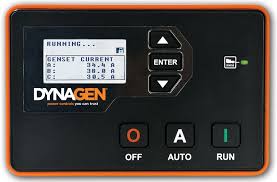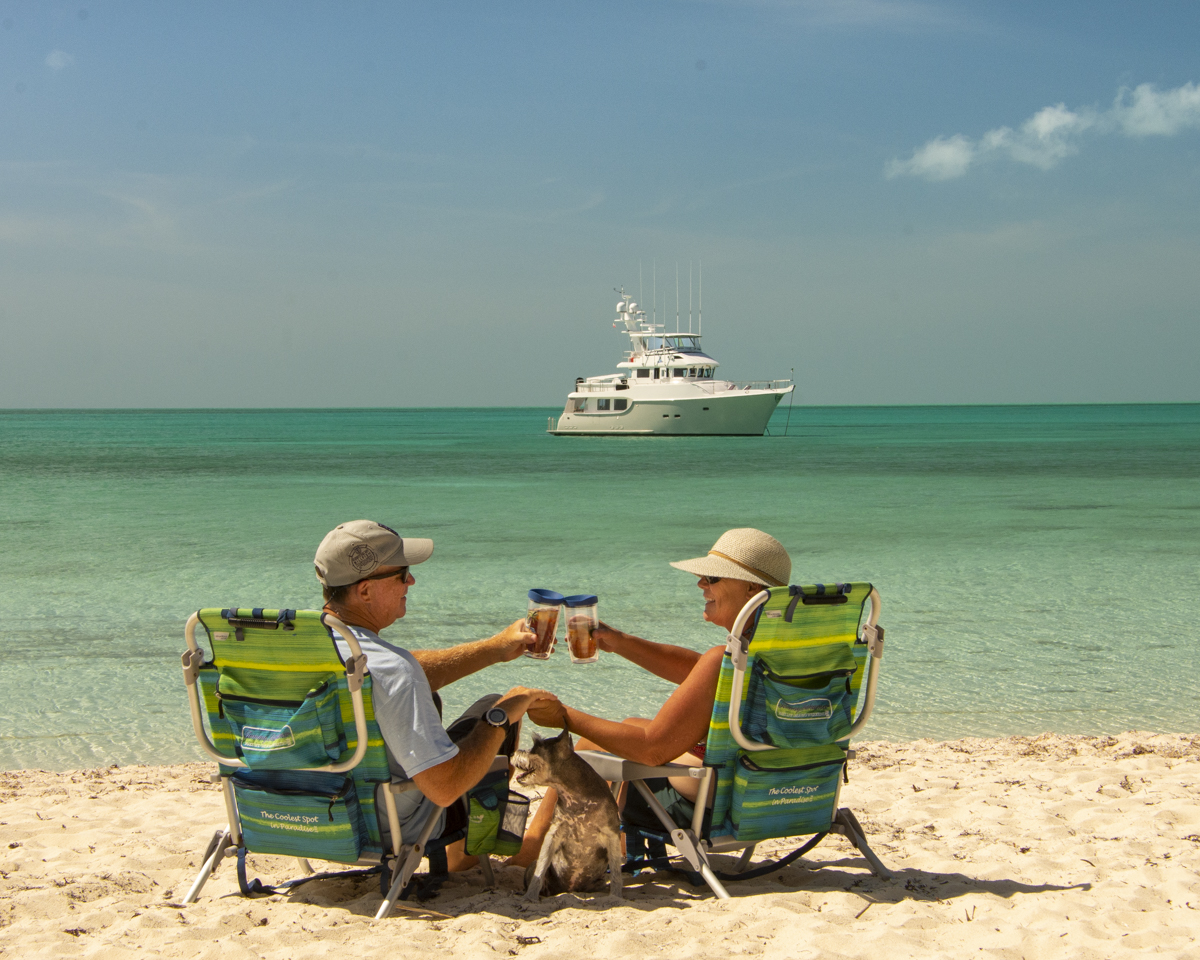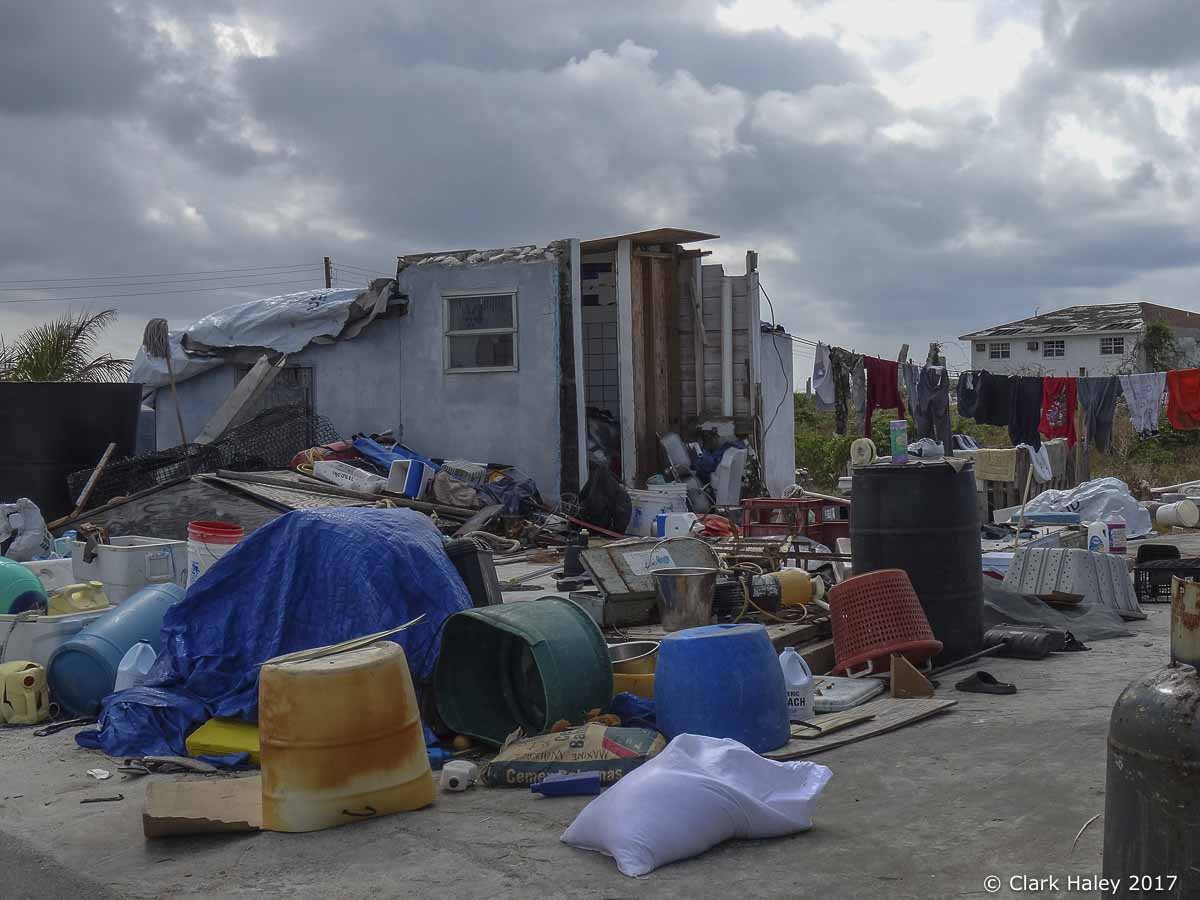 We recently upgraded Roam to include autostart on our generator. This means that if the batteries ever get low, the generator will come on automatically to charge the batteries and then shut down when the batteries are fully charged. That’s a huge deal on a boat like ours because the 1800 amp/hr battery bank usually needs to be charged at least twice per day in order to meet the piggish electrical requirements of Roam. Adding autostart to the generator means that Michelle and I don’t have to bother ourselves with a charging schedule and if we happen to be off the boat when the batteries get low, the generator will simply handle it!
We recently upgraded Roam to include autostart on our generator. This means that if the batteries ever get low, the generator will come on automatically to charge the batteries and then shut down when the batteries are fully charged. That’s a huge deal on a boat like ours because the 1800 amp/hr battery bank usually needs to be charged at least twice per day in order to meet the piggish electrical requirements of Roam. Adding autostart to the generator means that Michelle and I don’t have to bother ourselves with a charging schedule and if we happen to be off the boat when the batteries get low, the generator will simply handle it!
In boating, there are some subjects that emote very emotional points of view and autostart is a topic that generates a lot of heated discussion at the marina bar. Many experienced captains would argue that there are too many things that could go wrong if the generator runs unattended. The argument goes that if you let the generator start and run unattended, it could overheat and start a fire or water could back up through the exhaust and flood the generator’s engine, or sink the boat. In my opinion, a well designed autostart system will monitor the generator for all possible scenarios that could cause problems and shut the generator down (or not allow it to start in the first place) if a problem arises. Before making the decision to install autostart, I carefully weighed the pros and cons. For me, the pros far out weighed the very minor chance of a catastrophic system failure. In the end, each boat owner will make the decision that is best for him/her, given his/her specific circumstances.
Why Autostart?
Here are some of the reasons that I believe Autostart is worth having:
- If we’re at anchor and want to leave the boat for more than 10-12 hours, autostart will insure the batteries don’t ever fall below a minimum level while we’re away.
- If we leave the boat in a marina and the power goes out, we don’t have to worry that we’ll come back to dead batteries and spoiled fridge/freezers.
- We no longer have to delay a shore excursion because we’re waiting on the batteries to charge.
- This forth benefit was actually unexpected. With autostart, I sleep much better at night. You see, I used to wake up multiple times during the night to check on the battery bank’s state of charge. I was constantly doing the math to decide if I needed to get up and start the generator, or could I wait until morning to charge. Now that we have autostart installed I have one less thing to worry about on the boat — and that’s a big win in my book!
I have to give a huge thanks to James Hamilton (N52 Dirona) for his help as we worked through the challenges involved in implementing this system. After reading his excellent article on autostart and talking with him several times by email, he recommended that we look at the Dynagen TG410 autostart system for Roam.
Side note: I also researched using the autostart features built in to our Trace inverter/charge, but quickly eliminated that option because it would have required an electronics retrofit to the generator which was prohibitively expensive.
Roam is a 2003 Nordhavn 47 with a 16KW Northern Lights generator. On older boats like ours, the engines do not include the J1939 network. This presents some special challenges because there is no way to access the data (beyond viewing on the standard analog gauges). For this reason, we had to find a way to gather engine information and send start/stop and load/unload signals back to the generator based on that information. The Dynagen TG410 autostart controller includes the ability to wire directly to the analog sensors and makes the data available to a J1939 network. Dynagen has worked closely with Northern lights and has all the polars for the sensors which they preloaded in to the controller, so it was a simple matter to connect the sensor wires to the Dynagen wire loom. If your generator already includes J1939, the installation just got a whole lot simpler — all you will need to do is plug the Dynagen in to the J1939 network to access the data.
Installation Notes

I opted to install the TG410 controller in the engine room because it was easier to wire all the sensors with the controller mounted close to the generator. We mounted the controller on the sound shield. I also installed a remote control (TR100) so that I could start, stop, and monitor the generator from the pilothouse. We were able to use 2 of the wires (plus power and ground) from the old analog Northern Lights panel that was mounted in the pilothouse to run the remote panel, so there was no need to pull new wires up to the pilothouse.
One benefit of adding the TR100 in to the mix is that I now have the ability to plug in to the J1939 network at the remote controller in the pilot house. Maretron makes a J1939 to NMEA 2000 gateway that would publish all the sensor data to the NMEA2000 network. Perhaps that will be a Phase 3 of the project…
Installation of the TG410 was fairly straight forward. Using the Dynagen harness, we wired all the sensors from the engine directly to the controller. Dynagen provides the following data from the generator: engine temperature, exhaust manifold temperature, engine oil pressure, generator start battery voltage, engine RPM data (RPM is calculated from an analog sensor that measures flywheel rotations), output voltage by leg, amp load by leg, and output hertz.

To monitor battery bank voltage, we ran a wire from the main power bus (located in the lazarette on the N47) to the TG410. We installed an inline 5a fuse to the sensor wire. Monitoring battery voltage for a separate battery bank is not a standard configuration for Dynagen, but the TG410 has the ability to utilize up to 4 user defined data sources. We were able to configure one of the “slots” to monitor battery bank voltage and the threshold (minimum and maximum voltage) can be set in the configuration utilities.
We use a second slot to add or remove load from the generator during a warmup/cooldown period as well. The amount of time to wait for warmup/cooldown can be set in the configuration utilities.
A third slot is used to delay autostart for 15 minutes after the battery voltage falls below the minimum. This is necessary if you’re running any electrical items that draw the voltage down for a short period of time. The TG410 configuration currently only allows for a 90 second delay which is inadequate for our implementation. For example, consider the voltage drop caused by microwaving popcorn for 3 minutes. We overcame this shortcoming by installing a timer relay that I have set to delay startup for 15 minutes. Of course, if the voltage recovers within 15 minutes, the generator does not start and the timer resets.
Switching from Shore Power to Generator

As stated, above, one of the requirements for an autostart system is to provide a back up to shore power when we’re at a marina. The Power Transfer Switch on Roam is manual and if the Shore Power fails, someone would have to go aboard and change the Rotary Switch from Shore Power to Generator in order for the load to be picked up by the generator. The solution, was to install a relay that would automatically transfer load to the generator when needed. We ordered a new Rotary Cam switch from Salzer that included a 3rd position, which I have labeled “Auto.” We also ordered a Power Transfer relay that is designed to transfer power from Shore Power to Generator when it senses power coming from the generator. So, if we are at the dock running on shore power with the transfer switch in the Auto position and if the shore power fails, the inverter will run the on board systems until the battery bank reaches it’s minimum value. The generator will start and the relay will see power from the generator and switch the load to generator.
The Components List
My goal for implementing autostart on Roam was to use “off the shelf” components without any need for custom programming or configuration.It turned out to be only slightly more complicated than having a single vendor implement the system. Below is a list of components that I purchased with links to vendors. I’ve also included the price of each component as well as estimated labor, if you opt to hire someone to do the work.
| Product ID/Description | Vendor/Website | Price |
| #TG410 – Autostart Controller | Dynagen http://www.dynagen.ca | $1,232 |
| #TR100 – Remote Control Panel | Dynagen http://www.dynagen.ca | $455 |
| 4′ Dynagen Main CANBUS | Dynagen http://www.dynagen.ca | $30 |
| 4′ Dynagen Main I/O Harness | Dynagen http://www.dynagen.ca | $30 |
| 10′ Dynagen Flyout Pigtail Harness | Dynagen http://www.dynagen.ca | $246 |
| 4′ Dynagen Dash Mounting Plate | Dynagen http://www.dynagen.ca | $35 |
| #1885-1349-ND – Time Delay Relay | Digi-Key https://www.digikey.com | $29 |
| #PB177-ND – Socket for Time Delay Relay | Digi-Key https://www.digikey.ca | $14 |
| #S440L61100-003M1 – 3 position Rotary Cam Switch | Salzer http://www.salzerusa.com | $185 |
| #REL-36101 – Automatic Transfer Switch | Custom Marine Services http://www.cmsquick.com |
$875 |
| Labor for Install- 4-8 hours | Check with Dynagen for Dealers in your area | $400-$1000 |
| Total | $3,531-$3,931 |
Final Thoughts
Since we installed the autostart system early this summer, we have logged well over 100 nights on the hook in the Canadian Maritimes, Maine, and down the east coast as we’ve migrated south. We’re going to leave Roam in a slip at Brunswick Landing Marina in Georgia until late January, and it will be nice to leave the boat unattended and not worry about dock power for a change.
One interesting thing I’ve noticed is that the generator runs about 2.5 times in a 24 hour period (run time is set to 3 hours), which is more than I was running before converting to autostart, but I believe I’ll get better battery life because (1) I’m not letting the batteries get too low and (2) I’m letting the generator run long enough to get well beyond the bulk phase, so I’m getting a more complete charge each time the generator runs. This should improve the viable life of the batteries.
I have found the TG410 to be highly configurable and the folks at Dynagen have been very responsive to my questions and concerns. With that said, there are a few shortcomings that I hope they will address in a future version of their firmware:
- The start delay option needs to be configurable for up to at least 30 minutes (I have the external start delay set to 15 minutes and for my purposes, that’s adequate, but I want a simpler install with fewer components).
- The warmup/cool down feature requires the use of one of the custom relay slots and while it works perfectly well as we’ve configured it, I believe this should be a standard capability in the TG410.
- The TR100 remote control which is located in the pilot house does not allow me to view any of the sensor data UNLESS the generator is started. This means that if I want to check the hour meter, I have to either go to the engine room or start the generator to see the data on the remote.
Overall, this has been a great addition to the systems on Roam and I can’t imagine going back to a manual start generator at this point. If you have questions, concerns, ideas, please leave me a comment below.




Congratulations Clark, between you and James Hamilton you are paving the way for the rest of us to follow. Thanks very much for sharing this information. Mark Ethell, N52 MV Sally Forth
Mark, you can’t put me in the same category as James Hamilton, but thanks. I learned quite a lot from James prior to undertaking this project.
Clark, did you consider the Northern Lights autostart system and if so, share any thoughts about why you selected DynaGen?
Karl, I actually tried to buy autostart from NL, but I couldn’t get anyone to sell it to me – either direct or through a dealer. What they are selling, is actually the Same Dynagen TG410 controller. But their solution does not include the pilot house remote and you will still need to do something to switch the load from shore power to generator.
Thanks Clark,
Does your power transfer relay automatically switch back from generator to shore power when the shore power comes back on?
Karl, the power transfer switch is designed to switch load to the generator as soon as the generator starts. So, if the shore power goes out nothing will change until the battery bank voltage falls. At that point, the generator will start and the load will switch to the generator. If the shore power comes back on, the load will be switched back to the shore power as soon as the generator shuts down.
I’m a little concerned about the 5 amp fuse in the voltage sense circuit. Normally a sense circuit like this is very high impedance and very little current flows. Milliamps, or even microamps in some applications, but not whole amps. Typically the sense wires are very small gauge, perhaps larger for a very long run, and also typically in a twisted pair or shielded to reduce noise in the measured value. A fuse in such a circuit that does not open until it sees 5 amps or more seems like the wrong design choice. five amps flowing through that circuit means something is seriously wrong. if you are sensing a 12 volt battery bank this is 60 watts or more, and for a 24 volt bank it’s double that. Depending on the gauge of your sense wire you could experience excessive heating of the wire, or fire, or excessive damage to another component that might have been avoided with a smaller fuse that would open at under an amp. Typically I would use a half amp or less in a sense circuit and even that is orders of magnitude greater than the typical current flowing in the circuit.
Did I read it right, or is that circuit also used to power the Dynagen? If that’s the case then the larger fuse is probably appropriate, assuming that the wire gauge itself is sized correctly and the Dynagen needs a few amps to operate. if it’s got to power some relays then this would not be surprising.
Feel free to contact me if you want to discuss further.
Chris
Chris, thanks for your comments. You’re comment provides a new opportunity for learning! I believe I ran 18 or 24 gauge wire, but I’ll have to check and I didn’t think about running shielded wire. It would be super easy to replace the 5amp fuse with a 1 or .5 amp fuse. As to powering the TG410, that wire is not providing power. I’ll go back and study that further, for sure.
BTW, I need to go back and update the article, because the newest software update resolves the need for a separate relay and timer for the start delay. It works GREAT!
Hi Clark, good to hear back from you on this. Based on what you’ve said I would put the smallest (lowest amperage) fuse I could get my hands on in that circuit. I would definitely consider using shielded wire if the run is very long or runs adjacent to other equipment that may introduce noise in the sense wire.
18 or 24 ga. wire is a reasonable choice for a voltage sense circuit, depending on the length of the run. Accurately calculating the minimum acceptable gauge is a bit out of scope for this forum but there’s so little current in the measurement circuit that voltage drop due to wire resistance should not be a problem unless the run is really really long. Batteries are in the Laz, right? so your run is from there back to the vicinity of the generator in the aft end of the engine room. that’s not much distance.
I’ve spent most of my career in this field, dealing with these kinds of issues in hardware design, cabling, controlling noise, etc., to produce high quality measurements (and preventing systems from setting fire to themselves!) so if I can give you any more advice or electrical system design guidance please feel free to keep in touch.
Really great to hear about the improvement to the TG410 eliminating the extra relay and timer. This is definitely on my must-have list for my future Nordhavn (looking at 47 and 55).
Chris
Hi,
I know it’s been a few years but curious if you are still happy with this system? (Did you put one on the new boat?). I’m looking to add auto start to my 12kw northern lights. Anything you would do differently?
Thanks!
I liked it so much that I added an autostart to my 20KW generator when I upgraded to a Nordhavn 55. The Model AS that I bought is the same, but they’ve upgraded the software with many new features that precluded some of the workarounds that I had to install on the first Dynagen! Good luck!!
Thanks! Hope to have someone do the install in the next few weeks. Two quick questions:
1. Have the delays been added in you were looking for that allowed you to have a longer time delay for voltage before a start is triggered or do you still use a time delay relay. Also are you just using voltage now or a single from your inverter to start?
2. How are you keeping load off of the Generator during startup and shutdown, is that a 2 pole contactor/relay controlled by the Dynagen or something else?
I won’t be doing the transfer switch at the panel until I redo my panel next year sometime so will need to manually put my rotator switch on Gen to use autostart.
Thanks much!
Arthur
Great post!
I’m ordering some parts to do the same for our 9kw NL.
Just wondering…
Did you consider using the NL control panel wires and mounting the TG410 in the pilot house instead of using remote?
Do you have any diagrams of wiring between TG410 and NL?
Thanks for any guidance!
Jeff,
I have the same question about mounting the TG410 in the pilot house. The Dynagen wiring harnesses are approximately 4′. Did you extend them for your install?